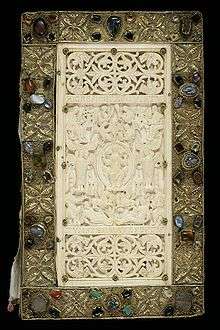Tuotilo
Saint Tuotilo (Tutilo, Tutilo von Gallen, Tutilo of Gall, Tutilo of Saint Gall) (c. 850 – c. 915) was a medieval monk and composer.
Life
Born in Alemannic Germany,[1] he is said to have been a large and powerfully built man, and an excellent boxer. Always cheerful and in excellent spirits, he was a general favorite.[2] He received his education at St. Gall's, from Iso and the Irishman Moengall, teachers in the monastic school.[3] He was the friend of Notker of St. Gall, with whom he studied music under Moengal. Educated at the Abbey of St. Gall, he remained to become a monk there.
Tuotilo was a poet, hymnist, architect, painter, sculptor, metal worker, and composer. His artistic interests included book illumination and music.[4]
Tuotilo was a good speaker, had a fine musical voice, was a capital carver in wood, and an accomplished illuminator. Like most of the earlier monks of St. Gall, he was a clever musician, equally skilful with the trumpet and the harp. Besides being teacher of music in the upper school to the sons of the nobility, he was a classical tutor and could preach both in Latin and Greek. His chief accomplishments, however, were music and painting, and on these his reputation mainly rests. He was much in request and by the permission of his abbot travelled to distant places. One of his celebrated sculptures was the image of the Blessed Virgin for the cathedral at Metz. In addition, he was a mathematician and astronomer, and constructed an astrolabe or orrery, which showed the courses of the planets.[2]

Tuotilo's music
Tuotilo played several instruments, including the harp. The history of the ecclesiastical drama begins with the trope sung as Introit of the Mass on Easter Sunday. It has come down to us in a St. Gallen manuscript dating from the time of Tuotilo. According to the works catalogue of Ekkehard IV, Casus sancti Galli, Tuotilo is the author of five tropes; further research ascribed five further tropes to him.[5] Some of them are available in modern editions.[6]
Tuotilo's art
James Midgley Clark points out that the most interesting items at the St. Gallen Abbey in Switzerland are the ivory tablets attributed to Tuotilo, which form the cover of the Evangelium Longum.[4] Tuotilo's paintings can be found at Konstanz, Metz, St. Gallen, and Mainz.
Veneration
Tuotilo was buried at a chapel dedicated to Saint Catherine in St. Gall, which was later renamed for him. His feast day is celebrated on March 28. St. Tuotilo is the patron saint of speech therapists.
See also
References
- According to his biographer, who based his account on Ekkehard IV, Tuotilo was of Alemannic origin, see Rüsch, Ernst Gerhard: Tuotilo. Mönch und Künstler. Beiträge zur Kenntnis seiner Persönlichkeit (St. Gallen, 1953).
- Bradley, John W. "Illuminated Manuscripts"
- Kampers, Franz, and Klemens Löffler: "Notker", in: The Catholic Encyclopedia vol. 11 (New York: Robert Appleton Company, 1911). 23 May 2013
- Mellby, Julie L.: "S. Gallus panem porrigit urso", in: Graphic Arts (Princeton University Library), 22 May 2012
- Listed in Klaper, Michael: "Tuotilo", in: Die Musik in Geschichte und Gegenwart (MGG2), biographical part, vol. 16, ed. Ludwig Finscher (Kassel: Bärenreiter, 2006), cc. 1120–1.
- Arlt, Wulf: "Komponieren im Galluskloster um 900. Tuotilos Tropen 'Hodie cantandus est' zur Weihnacht und 'Quoniam dominus Iesus Christus' zum Fest des Iohannes evangelista", in: Schweizerisches Jahrbuch für Musikwissenschaft, Neue Folge, vol. 15 (1995), pp. 41–70.